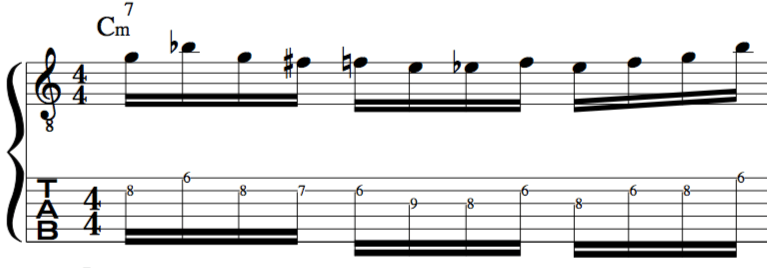Breaking down Michael Brecker!
When looking at musical notation it can seem like random notes. But if we break down each group into 4 note groupings called “Tetrachords” or “CELLS” we can break down the music theory and play each group on our instrument.
We can then remember the “Sound and Shape” of each cell and then join them together. In turn we can then apply these cells to our own instrumental playing/improvisations.
[For the advanced improviser you could break this into “Hexachords”, but for this lesson we will apply 4 note cells].
FULL SOLO LINE/PHRASE

1st Grouping of 4 notes [Tetrachord]=E flat Pentatonic shapE [F Mixolydian]

2nd Tetrachord=A flat Minor triad and 4th interval [or #11 #9 and #5] THE

3rd Tetrachord=Minor scale fragment with #11 added

4th Tetrachord=Changing cell. [From flat 9 to C melodic minor]

5th Tetrachord=C Lydian [Major].

6th Tetrachord =D major Pentatonic shape [ C LYDIAN leaning AGAIN]

7th Tetrachord=C minor arpeggio and 4th TO F TONIC NOTE

8th Tetrachord=F MAJOR SCALE FRAGMENT

9th Tetrachord=F LYDIAN [FLAT 7]

10th Tetrachord = VERY OUTSIDE. F SHARP 9

Lastly= Flat 6 for C minor

CONCLUSION:
In terms of fingering and musical application on our instruments learning shapes and “Connections” and breaking phrases down into 4 note cells [Tetrachords] is really useful because complex lines can be understood and learnt quickly.
In turn this gives us lots of patterns for improvisation and theoretical knowledge to improvise with as opposed to just playing scales and arpeggios.
If you found this easy then try and break this solo down into“Hexatonic” scale application. You might find it really interesting!
IF THIS LESSON WAS OF USE TO YOU THEN PLEASE SUBSCRIBE TO US BELOW ON YOUTUBE, THANKS!

MICHAEL BRECKER #2
CHROMATICS AND CELL [TETRACHORD] REPLICATION

Played 8va
To begin with we have a bit of standard Be Bop chromaticism

BUT!
If we look further we can see that we have an exact replicated cell that descends in minor 3rds weaving in and out of the harmony.
4 note cell

2 four note cells descending in minor 3rds replicated

We can now look at the whole line and see and hear where the descending replicated cells in minor 3rds start and how they serve their purpose.

IF THIS LESSON WAS OF USE TO YOU THEN PLEASE SUBSCRIBE TO US BELOW ON YOUTUBE, THANKS!

